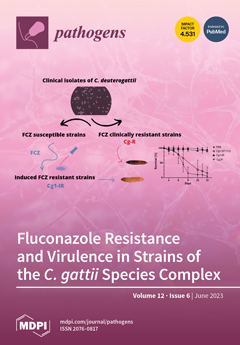Human angiostrongylosis is an emerging zoonosis caused by the larvae of three species of metastrongyloid nematodes of the genus
Angiostrongylus, with
Angiostrongylus cantonensis (Chen, 1935) being dominant across the world. Its obligatory heteroxenous life cycle includes rats as definitive hosts, mollusks as intermediate
[...] Read more.
Human angiostrongylosis is an emerging zoonosis caused by the larvae of three species of metastrongyloid nematodes of the genus
Angiostrongylus, with
Angiostrongylus cantonensis (Chen, 1935) being dominant across the world. Its obligatory heteroxenous life cycle includes rats as definitive hosts, mollusks as intermediate hosts, and amphibians and reptiles as paratenic hosts. In humans, the infection manifests as
Angiostrongylus eosinophilic meningitis (AEM) or ocular form. Since there is no comprehensive study on the disease in the Indian subcontinent, our study aims at the growing incidence of angiostrongylosis in humans, alongside its clinical course and possible causes. A systematic literature search revealed 28 reports of 45 human cases from 1966 to 2022; eosinophilic meningitis accounted for 33 cases (75.5%), 12 cases were reported as ocular, 1 case was combined, and 1 case was unspecified. The presumed source of infection was reported in 5 cases only. Importantly, 22 AEM patients reported a history of eating raw monitor lizard (
Varanus spp.) tissues in the past. As apex predators, monitor lizards accumulate high numbers of L3 responsible for acute illness in humans. For ocular cases, the source was not identified. Most cases were diagnosed based on nematode findings and clinical pathology (primarily eosinophilia in the cerebrospinal fluid). Only two cases were confirmed to be
A. cantonensis, one by immunoblot and the other by q-PCR. Cases of angiostrongylosis have been reported in Delhi, Karnataka, Kerala, Maharashtra, Madhya Pradesh, Puducherry, Telangana, and West Bengal. With a population of more than 1.4 billion, India is one of the least studied areas for
A. cantonensis. It is likely that many cases remain undetected/unreported. Since most cases have been reported from the state of Kerala, further research may focus on this region. Gastropods, amphibians, and reptiles are commonly consumed in India; however, typical preparation methods involve cooking, which kills the nematode larvae. In addition to studying rodent and mollusk hosts, monitor lizards can be used as effective sentinels. Sequence data are urgently needed to answer the question of the identity of
Angiostrongylus-like metastrongylid nematodes isolated from all types of hosts. DNA-based diagnostic methods such as q-PCR and LAMP should be included in clinical diagnosis of suspected cases and in studies of genetic diversity and species identity of nematodes tentatively identified as
A. cantonensis.
Full article






